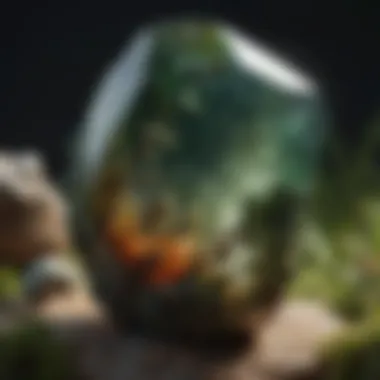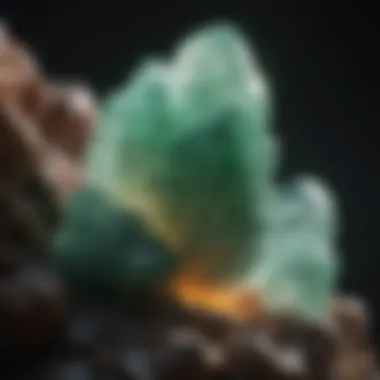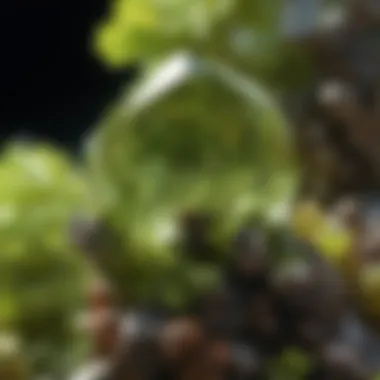Unveiling the Enigmatic World of Green Tumbled Crystal Identification


Rock and Fossil Identification
To delve into the world of green tumbled crystal identification is to unlock the secrets of these mesmerizing geological treasures. Understanding the types of rocks and fossils in which these crystals form is vital. Green tumbled crystals can originate from various parent rocks like quartz, jade, or aventurine. Each type carries its own distinct characteristics, such as color variations, translucency, and unique markings. Enthusiasts need to observe textures, shapes, and any inclusions to accurately identify these gems. Tools such as magnifying lenses and polarizing filters can aid in examining their features closely.
Collecting Tips and Techniques
When it comes to collecting green tumbled crystals, employing best practices ensures a rewarding experience. Identifying prime collecting sites rich in these crystals is essential. Locations with serpentine and chlorite-rich rocks are known sources for green tumbled crystals. Out in the field, safely extracting specimens requires delicate handling and proper tools like chisels and brushes. By adhering to ethical collecting guidelines and respecting nature, collectors can contribute to sustainable practices in specimen acquisition.
Preservation and Display
Preserving the beauty of green tumbled crystals involves specific techniques. Optimal storage methods include using soft, non-abrasive materials to prevent scratches and maintaining stable humidity levels to avoid deterioration. Creative display ideas can showcase these crystals' natural allure, such as arranging them in themed arrangements or integrating them into decorative dioramas. By mastering preservation techniques and tasteful display approaches, collectors can exhibit their prized specimens with pride and elegance.
Geological Insights
Exploring the geological aspects of green tumbled crystals reveals their intricate formations. Understanding the geological processes that lead to the creation of these crystals unlocks insights into their origins. Green tumbled crystals hold historical significance, with some cultures attributing mystical properties to them. Notable discoveries in the field have shed light on new green tumbled crystal varieties and enhanced our knowledge of these captivating geological wonders.
Introduction to Green Tumbled Crystals: Delving into the World of Geological Mysteries
Defining Green Tumbled Crystals: Deciphering Nature's Masterpiece
When we talk about green tumbled crystals, we are referring to polished stones that have undergone a tumbling process to achieve their smooth and lustrous appearance. These crystals are typically sourced from raw mineral specimens and are transformed through tumbling to enhance their aesthetic appeal. Green tumbled crystals exhibit a range of shades, from deep emerald greens to serene moss greens, adding to their visual appeal.
Significance of Green Tumbled Crystals: Unveiling Nature's Artistry
The significance of green tumbled crystals transcends their visual charm. These crystals are known for their metaphysical properties, with each shade of green carrying its unique energy and symbolism. From promoting balance and harmony to fostering growth and renewal, green tumbled crystals play a vital role in spiritual practices and holistic healing. Understanding the significance of these crystals is key to harnessing their energy and harnessing their potential benefits. Dive deep into the world of green tumbled crystals to unlock their secrets and tap into their positive vibrations.


Characteristics of Green Tumbled Crystals
Color Variations
Emerald Green
Emerald Green stands out as a prominent color variation among green tumbled crystals. It exhibits a vivid and rich green hue, reminiscent of the lushness of nature. Its striking coloration adds a touch of elegance and sophistication to any crystal collection. One of the key characteristics of Emerald Green is its association with abundance and prosperity, making it a favored choice for those seeking positive energy and growth. The unique feature of Emerald Green lies in its ability to promote harmony and balance, making it a valuable addition to this exploration of green tumbled crystal identification.
Moss Green
Moss Green presents a more subdued and earthy tone compared to Emerald Green. Its soft and calming appearance evokes a sense of tranquility and connection to nature. The key characteristic of Moss Green is its grounding properties, helping individuals feel centered and rooted in their surroundings. While not as vibrant as Emerald Green, Moss Green's understated beauty and soothing vibes make it a popular choice for crystal enthusiasts looking to enhance their sense of well-being. Its unique feature lies in its ability to foster emotional healing and growth, adding depth to the exploration of green tumbled crystal identification.
Forest Green
Forest Green embodies the essence of the natural world, evoking images of lush forests and verdant landscapes. The key characteristic of Forest Green is its association with vitality and rejuvenation, symbolizing renewal and growth. Its deep and serene color palette conveys a sense of stability and balance, making it a sought-after choice for those seeking harmony and peace. The unique feature of Forest Green is its ability to instill a sense of inner resilience and strength, encouraging personal development and self-discovery.
Texture and Surface Features
The texture and surface features of green tumbled crystals play a significant role in their identification and aesthetic appeal. The smooth and polished surfaces of these stones enhance their visual allure, reflecting light in unique ways that captivate the observer. The tactile experience of touching a green tumbled crystal reveals its quality and craftsmanship, highlighting the fine details and intricate patterns that adorn each piece. The texture variations, from silky-smooth to slightly rough textures, contribute to the overall charm and individuality of these geological wonders.
Transparency and Clarity
Transparency and clarity are essential aspects of green tumbled crystals that influence their beauty and value. The level of transparency determines how light passes through the crystal, affecting its brilliance and luminosity. Crystals with high clarity allow for clear visibility of internal features, such as inclusions or color variations, adding depth and character to the stone. Understanding the transparency and clarity of green tumbled crystals not only aids in their identification but also reveals insights into their quality and authenticity, enhancing the overall appreciation for these captivating geological treasures.
Types of Green Tumbled Crystals
In the realm of green tumbled crystals, understanding the different types holds immense importance as it allows enthusiasts and collectors to delve deeper into the captivating world of geological wonders. Each type of green tumbled crystal possesses its own unique characteristics, properties, and benefits, making them all the more fascinating to explore. By comprehensively discussing the various types, this article aims to equip readers with the knowledge needed to appreciate and differentiate these mesmerizing stones.


Jade
Jade, a highly esteemed and treasured stone, holds a prominent place among green tumbled crystals. Renowned for its stunning variations of green hues ranging from pale to deep emerald, jade exudes a sense of elegance and serenity. Apart from its aesthetic appeal, jade is believed to possess powerful healing and protective properties, making it a sought-after gem among crystal enthusiasts. When examining jade, factors such as translucency, color intensity, and overall texture play vital roles in determining its quality and authenticity. Its cultural significance in various traditions further enhances its allure, making it a must-have addition to any crystal collection.
Aventurine
Aventurine, often referred to as the 'Stone of Opportunity,' is a versatile and soothing green tumbled crystal that captivates with its shimmering appearance. Known for its abundance inclusions, which give it a distinct sparkle known as 'aventurescence,' this crystal symbolizes growth, luck, and prosperity. Aventurine's gentle energy is believed to inspire creativity, enhance decision-making, and promote emotional well-being. Its smooth texture and vibrant green shades make it a popular choice for jewelry and ornamental pieces. Understanding the unique patterns of aventurine and its metaphysical properties adds a layer of intrigue to this enchanting crystal.
Green Calcite
Green Calcite, with its calming and refreshing energy, serves as a rejuvenating force within the realm of green tumbled crystals. This translucent stone exhibits varying shades of green, from soft pastel hues to deep emerald tones, captivating the beholder with its natural beauty. Green Calcite is prized for its cleansing properties, as it is believed to rid the body of negative energy and promote harmony and balance. When exploring Green Calcite, its unique crystal structure, clarity, and soothing vibrations set it apart, making it a popular choice for meditation practices and energy work. Incorporating Green Calcite into daily routines can infuse a sense of tranquility and vitality, making it a cherished addition to any crystal collection.
Identification Techniques
Color Examination
Color examination serves as a fundamental aspect of identifying green tumbled crystals. By scrutinizing the hues present in a crystal, collectors can discern subtle differences that hint at its composition and authenticity. Emerald green, moss green, and forest green are among the diverse color variations that provide insights into the type of crystal being observed. Understanding the nuances of each shade equips enthusiasts with the knowledge needed to accurately identify and appreciate the unique characteristics of different green tumbled crystals.
Crystal Structure Analysis
Delving deeper into identification techniques, crystal structure analysis plays a crucial role in differentiating green tumbled crystals. Examining the internal composition and arrangements of atoms within a crystal sheds light on its mineralogical properties and distinct features. By studying the crystal structure, collectors can unveil valuable information about the formation process, clarity, and potential enhancements, thereby aiding in accurate identification and appreciation of these geological wonders.
Expert Consultation
Seeking expert consultation emerges as a valuable resource in the realm of green tumbled crystal identification. Experienced professionals possess specialized knowledge and insights that can guide enthusiasts in navigating the complexities of crystal identification. Consulting experts can provide invaluable tips, interpretations, and recommendations based on years of expertise and practical experience, empowering collectors to make informed decisions and deepen their understanding of these mesmerizing geological treasures.
Common Confusions and Misidentifications


In the realm of green tumbled crystal identification, understanding common confusions and misidentifications is paramount to mastering the art of differentiating these exquisite geological specimens. By delving into this crucial aspect, enthusiasts and collectors can refine their knowledge and enhance their ability to discern between similar stones with confidence and precision.
One fundamental point of emphasis within this article is to shed light on the subtle differences that can lead to misidentifications, emphasizing the significance of attention to detail in distinguishing green tumbled crystals. By highlighting specific visual cues, structural variations, and unique properties of each stone, readers will be equipped with the discerning eye needed to navigate the nuances within this specialized field.
Furthermore, addressing common confusions serves a dual purpose of not only preventing misidentifications but also deepening one's appreciation for the diversity and complexity present within the sphere of green tumbled crystals. Embracing the challenge of differentiating similar stones can unveil a deeper understanding of geological processes and crystal formations, broadening the perspective of enthusiasts and fostering a deeper connection to these natural treasures.
Differentiating Similar Green Stones
When it comes to distinguishing between similar green stones, the key lies in honing in on specific characteristics that set each type apart. By focusing on attributes such as color variations, texture, and crystal structure, collectors can unravel the distinctive traits that define individual stones within the green tumbled crystal spectrum.
One pivotal aspect to consider is the hue of the stone, as subtle differences in shades of green can be indicative of different mineral compositions and origins. Examining the depth of color, undertones, and any unique patterns can serve as valuable markers for identification, aiding in the differentiation process.
Texture and surface features also play a crucial role in differentiating similar green stones, as variations in smoothness, graininess, or the presence of visible inclusions can provide clues to the stone's identity. Understanding how light interacts with the surface of the crystal and paying attention to any irregularities can further enhance one's ability to distinguish between visually comparable stones.
Moreover, delving into the crystal structure of each stone can offer insights into its formation process and geological history. By analyzing the internal arrangements of atoms and molecules, collectors can uncover distinctive patterns, cleavage angles, and growth patterns that are unique to each type of green tumbled crystal.
Avoiding Mislabeling
Mislabeling can be a common pitfall in the world of green tumbled crystal identification, often leading to confusion and misinformation within collector communities. To steer clear of this issue, meticulous attention to detail and a discerning approach to classification are essential.
One effective strategy for avoiding mislabeling is to consult reliable sources and reference guides that provide accurate information on green tumbled crystals. By cross-referencing multiple sources and seeking expert opinions when in doubt, collectors can ensure the accuracy of their identifications and minimize the risk of misinformation.
Additionally, cultivating a systematic approach to cataloging and documenting green tumbled crystals can help prevent mislabeling errors. Implementing proper labeling techniques, organizing specimens methodically, and maintaining detailed records of each crystal's unique characteristics can facilitate accurate identification and prevent confusion among collectors.
By prioritizing precision, thoroughness, and a meticulous approach to classification, enthusiasts can navigate the intricate world of green tumbled crystal identification with confidence and accuracy, enriching their collecting experience and expanding their knowledge of these stunning geological wonders.
Conclusion
This article encapsulates the essence of green tumbled crystal identification, offering a comprehensive guide for both novice collectors and seasoned experts alike. By providing a detailed understanding of color variations, texture, and crystal structure analysis, individuals can navigate the world of green tumbled crystals with confidence and expertise. Through expert consultations and meticulous examination, the process of identifying these geological wonders is demystified, paving the way for a deeper appreciation of their beauty and significance.
Final Thoughts on Green Tumbled Crystal Identification
Addressing the intricate nuances of green tumbled crystal identification unveils a world of mesmerizing geological treasures waiting to be explored. As enthusiasts immerse themselves in the diverse shades of emerald green, moss green, and forest green, a profound appreciation for the beauty and uniqueness of each crystal emerges. By honing in on color examination, texture, and transparency, collectors can unravel the mysteries hidden within each stone, allowing for accurate identification and categorization.







